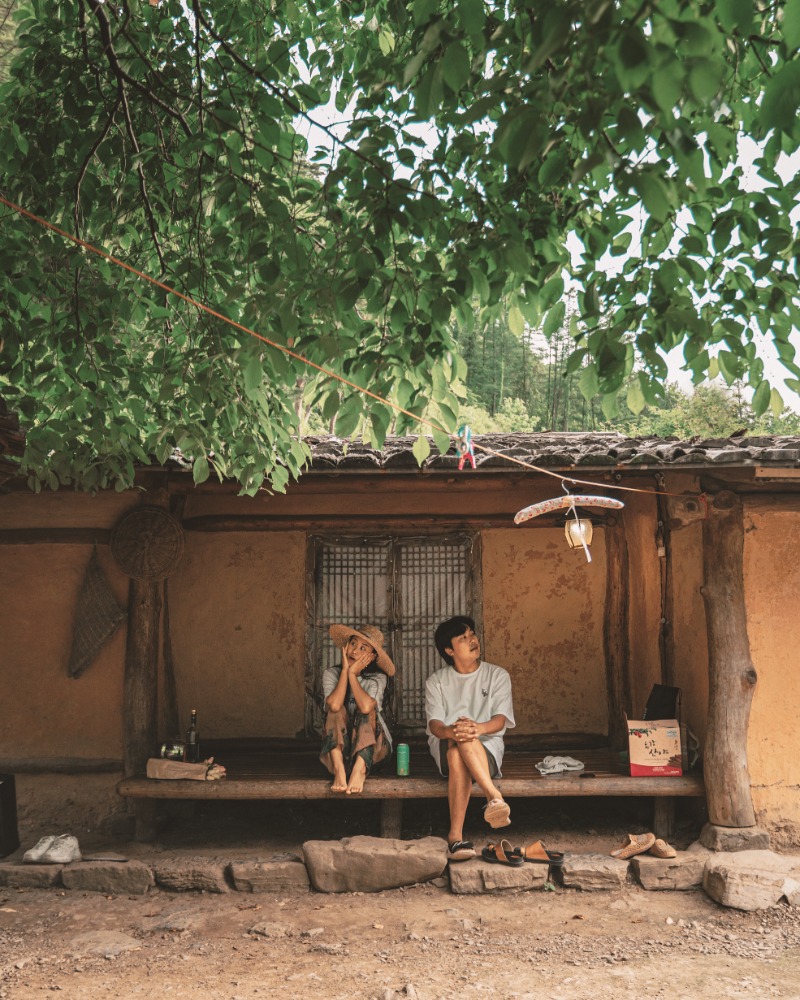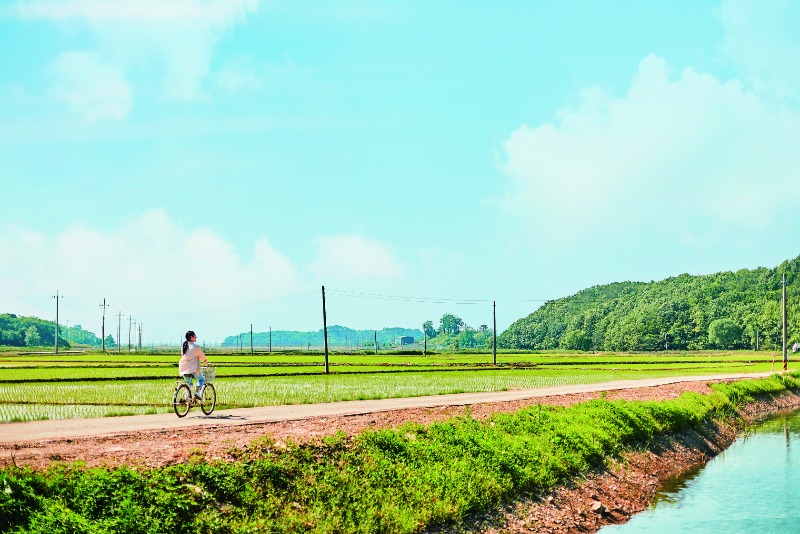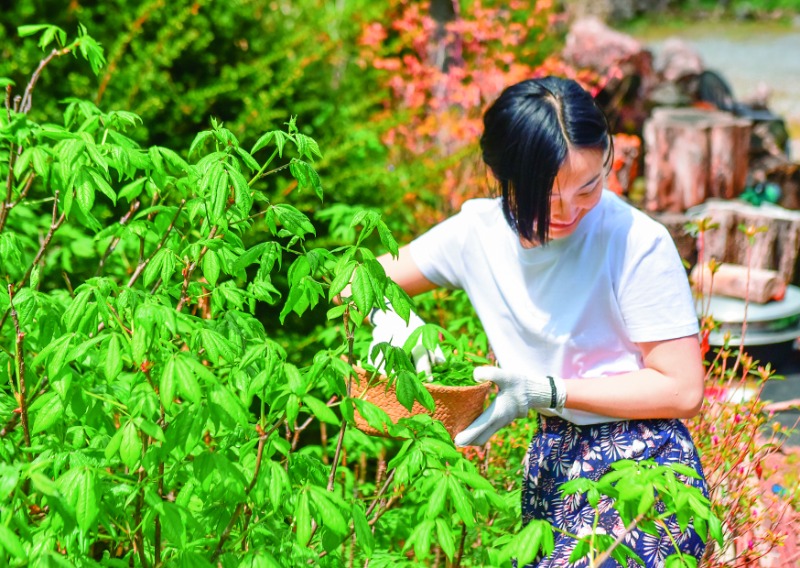The definition of a “staycation,” a portmanteau of “stay” and “vacation,” has stretched from a handful of days to a month or more. Its sister concept, “workcation,” is an outgrowth of remote working that emerged during the COVID-19 pandemic. These lifestyle trends show no signs of abating.

Travel writer Won Yu-ri and her husband participated in a monthlong “staycation” project in Yeongwol County, Gangwon Province. Her Instagram account (@travel_bellauri) appeared in a series of essays collectively called “That Summer, Youthful Month.”
ⓒ travel_bellauri
The end to pandemic-related lockdowns and restrictions means unrestricted international travel is bouncing back. However, many Koreans are not pocketing their passports but instead taking care of their travel itch with extended staycations. But rather than staying at a nice hometown hotel for a few days, these staycations are lasting for weeks somewhere in-country. For retirees and freelance workers, a lengthy staycation is an ideal way to introduce themselves to a new place without the hassles and potential troubles associated with foreign travel.
This approach has also morphed into workcations. During the pandemic, many office workers became so accustomed to laboring from home that they now prefer not to return to their office cubicles. Somewhat surprisingly, many companies are accommodating them, hoping happier employees will prove to be more energized and productive. This is a sea change from a few generations ago, when “face time” with colleagues was considered essential and staff dinners and heavy drinking were routine. Nowadays, young office workers are less receptive to that old corporate culture; their generation highly values new experiences. For them, a workcation is the perfect way to explore new sights while employing their tech know-how to work seamlessly outside their home office.
ESCAPING CITY LIFE
In the past, the travel industry marketed “work and travel” and “working holiday” packages. By the early 2010s, the step up to a staycation began to emerge. Jeju Island, off the tip of the Korean peninsula, became the epicenter of this shift.
Already a vacation favorite because of its stunning natural environment, the island province took on a new image thanks to Lee Hyori. Media images of the popular singer getting married at her house on Jeju and her leisurely pace of life — playing with her dogs, cutting beanstalks, riding a paddle board in the sea, and hiking up oreum (Jeju’s famous volcanic cones) — sparked widespread curiosity. Soon, those with enough money and free time began to fill up a mushrooming number of new guesthouses on the island.
Other provinces have jumped on the staycation bandwagon. There are package deals such as “Monthlong Tours in Jeolla,” “Monthlong Travel in Gyeongsang,” “A Good Time to Travel to Gimhae,” and “Come Live in Neowa Village for a Month.” The itineraries usually consist of visits to beautiful travel spots and places to savor local delicacies, as well as hands-on experience at farms.

An increasing number of local governments are supporting “staycation” projects, as more and more people like the idea of having a “workcation.” Empty homes at attractive sites are an appealing option with the lifting of COVID-related restrictions on travelers.
ⓒ gettyimagesKOREA
VILLAGE HOTELS
More and more pleasure seekers want to spend their staycations in small towns that have turned themselves into living resorts. For example, the residents of Jemincheon, a village in the city of Gongju, South Chungcheong Province, have organized themselves to act as hotel employees. Gaga Sangjeom, a street-front store, plays the role of front desk; Café Banjukdong 247 is the lobby lounge; and hanok, traditional Korean houses, are the guest rooms. There are many attractions to see and gastro eateries on both sides of Jemincheon, the stream that gives the village its name.

Yeongwol County sponsors a “staycation” project during all four seasons of the year to stimulate public interest in the county. Poets, calligraphers, and travel writers are invited and their description of their stay is distributed for free.
ⓒ Yeongwol County
Village Hotel 18 in Jeongseon County, Gangwon Province, is the country’s oldest village hotel program. It kicked off in 2018, when Gohan, an abandoned mining town, recast and renamed itself “Village Hotel 18th Street.” The village community hall serves as a lounge, and vacationers who stay at one of the village’s unoccupied renovated houses are given discount coupons for eateries, a photo studio, and a barbershop. The program mirrors efforts across the country to repurpose housing in rural and fishing villages that have been emptied by steady migration to the big cities.
According to Statistics Korea, there were 1,395,256 unoccupied dwellings across the country as of 2021, including unsold apartments. To address this new social problem, the government permitted agricultural and fishing villages to operate lodging businesses in the empty houses. This paved the way for the owners to make use of the places they left behind in their hometowns and for investors to renovate and repurpose them.
WORKCATION
The rise of the digital age and the values of the younger generations have fueled the bulging popularity of workcations. High-tech gear and software applications allow desktop work to be done anywhere with an internet connection. In Korea, one of the most wired countries in the world, that means virtually any corner. At the same time, young Koreans in their 20s and 30s attach great importance to a healthy work-life balance. Working remotely all day and then stepping out into a relaxing, unexplored environment ticks off all the boxes.
The COVID-19 pandemic boosted the ranks of remote workers exponentially. There is no turning back for many workers and companies. Work-from-home, entirely or partially, is becoming the new norm, with workcations being an extension of the arrangement. Remote workers can recharge themselves and increase efficiency by working in new and unfamiliar places. At the extreme end, so-called digital nomads may not even keep a permanent home anymore, instead spending several months at a popular travel destination before moving on to another one.
“It’s exciting to experience quite a new environment and meet each day in a new place far from where I live,” says Choi Gap-soo, a poet and travel writer who last year spent a month in Gangneung, Gangwon Province.
“Every morning there felt new. The life I experienced was quite different from my usual routines up to that point. Everything was new and came as an inspiration. It was a rare chance to take a rest with no tension or stress in the body and mind. It also gave me a chance to appreciate the value of life. I decided to allow myself such a new month every year from now on.”

An area of Yeongwol County featured in “Lee Sulla’s Collection of Stories,” published in collaboration with the county government. Writer Lee Sulla delivers stories to readers every day through “Dailee-sulla,” an online service with daily updates. While staying in the county, Lee wrote snippets accompanied by photos of yoga meditation, wild flowers and plants, and vegan recipes.
ⓒ gettyimagesKOREA
A poll by the 2023 edition of Trend Korea, an annual book explaining Korean society’s latest likes and dislikes, found people across all groups chose rural areas as the best workcation spots because they offer serenity and proximity to nature. More time is needed before staycations and workcations become universal options for everyone. But with more and more Koreans desiring simple yet special experiences, travel experts believe staycations and variations of them are here to stay.
Choi Byung-il Writer